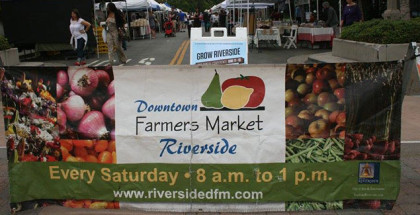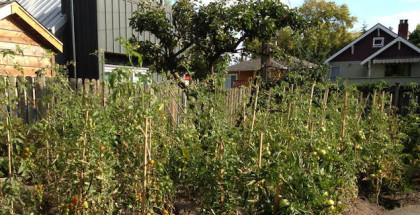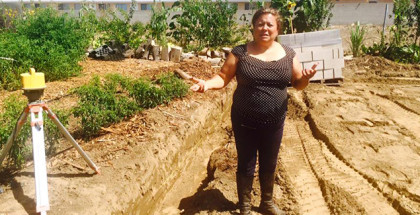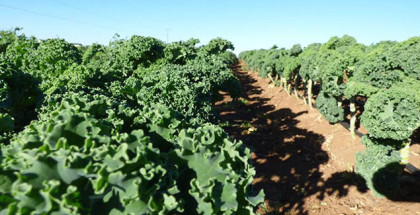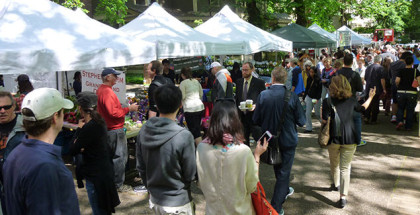Posts By AJ Hughes
From Blight to Opportunity: Detroit Woman Puts Kids to Work in Community Garden
January 28, 2016 | AJ Hughes
Riet Schumack (left) holds a check donation to the organization she helped cofound, Neighbors Building Brightmoor. (photo courtesy of Riet Schumack)
Riet Schumack not only has a heart for gardening and kids, but also for the city she loves and calls home: Detroit. And since 2006, her heart has led her to help inner city kids become gardeners, and in the process, transform blight to beauty.
In 2006, she co-founded the Brightmoor Youth Garden in Detroit’s Brightmoor neighborhood as a way to counteract prostitution and drug dealing in the area, as well as to provide a safe space for children. Read More
Urban Farming Program at Indiana High School Teaches Students to Farm and Embrace Entrepreneurship
January 20, 2016 | AJ Hughes
A student at Thea Bowman Leadership Academy handles chickens inside their coop at the school’s farm. (Photo courtesy Lynda Bodie/Thea Bowman Leadership Academy)
Gary, Indiana, known for being the birthplace of Michael Jackson and home to massive steel plants, now has a high school with an urban farm program.
Last year, students at Thea Bowman Leadership Academy in Gary started the urban farm. It’s founded and operated under the principles of a business plan written as part of an entrepreneurship and personal finance class curriculum. Read More
Looking forward, Riverside Food Systems Alliance Sets Eyes on Education, Health, and Local Food in the Region
January 19, 2016 | AJ Hughes
The Riverside Food Systems Alliance is striving for a thriving and equitable local foods system in Riverside and the surrounding areas. (Image courtesy Seth Wilson/Riverside Food Systems Alliance)
The Riverside Food Systems Alliance (RFSA), a public-private partnership with members from the community, government, and business sector works to grow a resilient and productive local food and agricultural system in the greater Riverside, CA region. The organization, which has been around for a little over a year continues to trace and mark its progress by looking back, and forward, to annual GrowRIVERSIDE conferences.
In 2014, the year of the first GrowRIVERSIDE event, consultant and former Seattle City Councilman Richard Conlin helped the group get established. With an original focus on Riverside’s Greenbelt, Conlin assisted in hammering out goals that would positively impact the community. These goals include sustainable agriculture and its economic viability in and near Riverside, California; agricultural economic development and infrastructure; education about food and agriculture; equitable access to healthy foods; and public health.
Shortly after the 2015 GrowRIVERSIDE conference, the RFSA formed a five-member board and an advisory board of more than 20 members. The organization also became a nonprofit with official 501(c)(3) status, hired a new executive director and secured a fiscal sponsor—Community Partners. Read More
CityCrop Venture Seeks to Address Future Water Needs of Urban Agriculture Operations
January 18, 2016 | AJ Hughes
A plot of land in Vancouver, British Columbia has served as the site of a research study to determine the water needs of urban agriculture. (Photo courtesy Mark Johnson)
Cities around the world are transforming blight into gardens, turning bleak rooftops into greenspace, and using empty buildings for vertical farming. But will this upsurge in urban agriculture create even more demand for water?
This is the question Mark Johnson, professor of water and sustainability at The University of British Columbia, is looking to address. Johnson, along with other colleagues, has developed a tool to measure just how much water urban agriculture operations need.
The tool, dubbed CityCrop, uses LiDAR (remote sensing technology—stands for Light Detection and Ranging) and climate readings to determine the level of shade provided by buildings and trees. This data helps scientists figure out city-dwelling plants’ rates of evapotranspiration, which in turn reveals their water needs. Read More
Grassroots Efforts Target Food Insecurity in San Bernardino County, CA
January 14, 2016 | AJ Hughes
A feast is enjoyed at Huerta Del Valle Community Garden in San Bernardino County. (photo courtesy of Arthur Levine/Huerta Del Valle)
San Bernardino County, the largest county in the United States, stretches all the way from Southern California’s Inland Empire to the California-Nevada state line.
In addition to numerous farms and other agricultural businesses, the county is home to Amy’s Farm, a polyculture-oriented farm in Ontario with a focus on education; Huerta del Valle, a robust community garden in Ontario; and the Upland-based Incredible Edible Community Garden.
Thanks to people like Arthur Levine, local and urban agriculture in San Bernardino County is experiencing a burgeoning grassroots movement. Read More
Financial Future Bright for Food Hubs, Study Says
January 12, 2016 | AJ Hughes
This map shows the number of farms with direct sales to restaurants and/or retail establishments as of 2012, and the locations of food hubs as of 2014. (image courtesy of Gary Matteson/Farm Credit Council)
Food hubs are viable businesses with bright futures, according to a recent financial study on food hubs.
The COUNTING VALUES: Food Hub Financial Benchmarking Study drew on financial and operational data from 48 of the more than 300 food hubs in the United States. The report aims to compare results within particular sectors to develop baseline performance statistics.
It’s also the first report of its kind to focus on food hub performance metrics. The report formally defines a regional food hub as “a business or organization that actively manages the aggregation, distribution, and marketing of source-identified products primarily from local and regional producers for the purpose of strengthening producer capacity and their access to wholesale, retail, and institutional markets.” Read More
Temecula Valley Emerging as Epicenter of Local Food and Agriculture in Riverside County
January 11, 2016 | AJ HughesGrass-fed beef, yams, ostrich eggs, duck eggs, quail eggs, wild game—all of these and more can be found in or near Temecula, California.
Located in southwestern Riverside County and at the southwest point of the Inland Empire region, Temecula is located in the Temecula Valley, home to many vineyards and wineries.
While Temecula is now a thriving epicenter of the local foods movement, this was not always the case.
When local food artisan and chef Leah Di Bernardo decided to move back to Southern California from New York City (she grew up on both coasts), Riverside County was the last place she thought she would end up. But she landed in Temecula. Read More
Can Small Farmers Make a Profit at Farmers Markets?
December 30, 2015 | AJ HughesThe last decade has seen nothing short of a bonanza in farmers’ markets in America. Between 2007-2014, the number of farmers’ markets in the U.S. has grown by nearly 180 percent, according to a January 2015 USDA report. That’s accompanied by a 288 percent growth in regional food hubs and 430 percent in farm-to-school programs.
But the data also show that while food hub sales continue to climb, sales at farmers’ markets may have peaked.
So can farmers, especially ones who operate on a small scale, make enough money at farmers’ markets to make it worth their while? Or is the proliferation of farmers’ market we’ve seen over the last decade coming to an end? Read More


